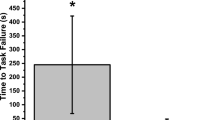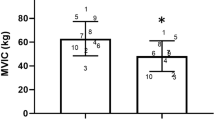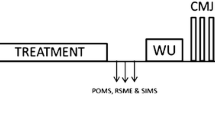Abstract
The aims of this study were (1) to investigate the relationship between self-perception of effort and task duration in an intermittent isometric fatigue trial (IIF) and (2) to evaluate the capability of two assessment paradigms (perceived exertion; perceived task duration) to reflect changes in IIF intensity. Fifteen participants performed two IIF tasks of the knee extensors at intensities of 60 and 70 % of daily peak force, each separated by 48–72 h. Ordering of the tasks was counter-balanced and participants were blinded to the precise intensity of each IIF. A category-ratio scale (CR-10) and visual analogue scale were used during each IIF task to record measures of perceived exertion and perceived task duration, respectively. Measures were recorded at 10 % intervals across the relative duration of each IIF task. Pearson product-moment correlation coefficients revealed strong positive correlations (r > 0.99; p < 0.01) between completed task duration and both perceptual scales at the two IIF intensities. Separate two-way repeated measures ANOVAs of CR-10 and perceived task duration responses revealed significant main effects for time only (F [2.2,30.1] = 126.8; p < 0.001; F [2.6,36.8] = 117.2; p < 0.001, CR-10 and perceived task duration, respectively). The results suggest that perceived exertion and perceived task duration are equally effective predictors of IIF end-point. However, neither measure was sufficiently responsive to discriminate between 10 % changes in exercise intensity.


Similar content being viewed by others
Abbreviations
- CR-10:
-
Category-ratio scale
- CTD:
-
Completed task duration
- EMD:
-
Electromechanical delay
- IIF:
-
Intermittent isometric fatigue task
- PF:
-
Peak force
- PTD:
-
Perceived task duration
- RFD:
-
Rate of force development
- TD:
-
Task duration
References
Bangsbo J, Madsen K, Kiens B, Richter EA (1996) Effect of muscle acidity on muscle metabolism and fatigue during intense exercise in man. J Physiol 495(Pt 2):587–596
Behm DG, St-Pierre DM (1997) Effects of fatigue duration and muscle type on voluntary and evoked contractile properties. J Appl Physiol 82(5):1654–1661
Crewe H, Tucker R, Noakes TD (2008) The rate of increase in rating of perceived exertion predicts the duration of exercise to fatigue at a fixed power output in different environmental conditions. Eur J Appl Physiol 103(5):569–577
Eston R, Faulkner J, St Clair Gibson A, Noakes T, Parfitt G (2007) The effect of antecedent fatiguing activity on the relationship between perceived exertion and physiological activity during a constant load exercise task. Psychophysiology 44(5):779–786
Garland SJ (1991) Role of small diameter afferents in reflex inhibition during human muscle fatigue. J Physiol 435:547–558
Gleeson NP, Naish PF, Wilcock JE, Mercer TH (2002) Reliability of indices of neuromuscular leg performance in end-stage renal failure. J Rehabil Med 34(6):273–277
Horstman DH, Morgan WP, Cymerman A, Stokes J (1979) Perception of effort during constant work to self-imposed exhaustion. Percept Mot Skills 48(3 Pt 2):1111–1126
Li G, Rudy TW, Sakane M, Kanamori A, Ma CB, Woo SL (1999) The importance of quadriceps and hamstring muscle loading on knee kinematics and in situ forces in the ACL. J Biomech 32(4):395–400. S002192909800181X [pii]
McLean SG, Samorezov JE (2009) Fatigue-induced ACL injury risk stems from a degradation in central control. Med Sci Sports Exerc 41(8):1661–1672
Minshull C, Gleeson N, Walters-Edwards M, Eston R, Rees D (2007) Effects of acute fatigue on the volitional and magnetically-evoked electromechanical delay of the knee flexors in males and females. Eur J Appl Physiol 100(4):469–478
Minshull C, Gleeson NP, Eston RG, Bailey A, Rees D (2009) Single measurement reliability and reproducibility of volitional and magnetically-evoked indices of neuromuscular performance in adults. J Electromyogr Kinesiol 19(5):1013–1023
Minshull C, Rees D, Gleeson NP (2011) Joint angle affects volitional and magnetically-evoked neuromuscular performance differentially. J Electromyogr Kinesiol 21(4):672–677. S1050-6411(11)00039-3 [pii]
Noakes TD (2004) Linear relationship between the perception of effort and the duration of constant load exercise that remains. J Appl Physiol 96(4):1571–1572; author reply 1572–1573
Noble BJ, Robertson RJ (1996) Perceived exertion. Human Kinetics, Champaign
Nordlund MM, Thorstensson A, Cresswell AG (2004) Central and peripheral contributions to fatigue in relation to level of activation during repeated maximal voluntary isometric plantar flexions. J Appl Physiol 96(1):218–225. doi:10.1152/japplphysiol.00650.2003
Pincivero DM, Coelho AJ, Erikson WH (2000) Perceived exertion during isometric quadriceps contraction. A comparison between men and women. J Sports Med Phys Fit 40(4):319–326
Pincivero DM, Coelho AJ, Campy RM, Salfetnikov Y, Suter E (2003) Knee extensor torque and quadriceps femoris EMG during perceptually-guided isometric contractions. J Electromyogr Kinesiol 13(2):159–167. S1050641102000962 [pii]
Seymour RA, Simpson JM, Charlton JE, Phillips ME (1985) An evaluation of length and end-phrase of visual analogue scales in dental pain. Pain 21(2):177–185
Shimano T, Kraemer WJ, Spiering BA, Volek JS, Hatfield DL, Silvestre R, Vingren JL, Fragala MS, Maresh CM, Fleck SJ, Newton RU, Spreuwenberg LP, Hakkinen K (2006) Relationship between the number of repetitions and selected percentages of one repetition maximum in free weight exercises in trained and untrained men. J Strength Cond Res 20(4):819–823. R-18195 [pii]
Thomas GA, Kraemer WJ, Spiering BA, Volek JS, Anderson JM, Maresh CM (2007) Maximal power at different percentages of one repetition maximum: influence of resistance and gender. J Strength Cond Res 21(2):336–342. R-55001 [pii]
Ulmer HV (1996) Concept of an extracellular regulation of muscular metabolic rate during heavy exercise in humans by psychophysiological feedback. Experientia 52(5):416–420
van Grinsven S, van Cingel RE, Holla CJ, van Loon CJ (2010) Evidence-based rehabilitation following anterior cruciate ligament reconstruction. Knee Surg Sports Traumatol Arthrosc 18(8):1128–1144. doi:10.1007/s00167-009-1027-2
West SJ, Smith L, Lambert EV, Noakes TD, St Clair Gibson A (2005) Submaximal force production during perceptually guided isometric exercise. Eur J Appl Physiol 95(5–6):537–542. doi:10.1007/s00421-005-0004-9
Yoon T, Schlinder Delap B, Griffith EE, Hunter SK (2007) Mechanisms of fatigue differ after low- and high-force fatiguing contractions in men and women. Muscle Nerve 36(4):515–524. doi:10.1002/mus.20844
Zebis MK, Bencke J, Andersen LL, Alkjaer T, Suetta C, Mortensen P, Kjaer M, Aagaard P (2010) Acute fatigue impairs neuromuscular activity of anterior cruciate ligament-agonist muscles in female team handball players. Scand J Med Sci Sports. doi:10.1111/j.1600-0838.2010.01052.x
Conflict of interest
The authors declare that they have no conflict of interest.
Author information
Authors and Affiliations
Corresponding author
Additional information
Communicated by Arnold de Haan.
Rights and permissions
About this article
Cite this article
Shepherd, J., Gleeson, N. & Minshull, C. Congruency and responsiveness of perceived exertion and time-to-end-point during an intermittent isometric fatigue task. Eur J Appl Physiol 113, 905–909 (2013). https://doi.org/10.1007/s00421-012-2496-4
Received:
Accepted:
Published:
Issue Date:
DOI: https://doi.org/10.1007/s00421-012-2496-4




